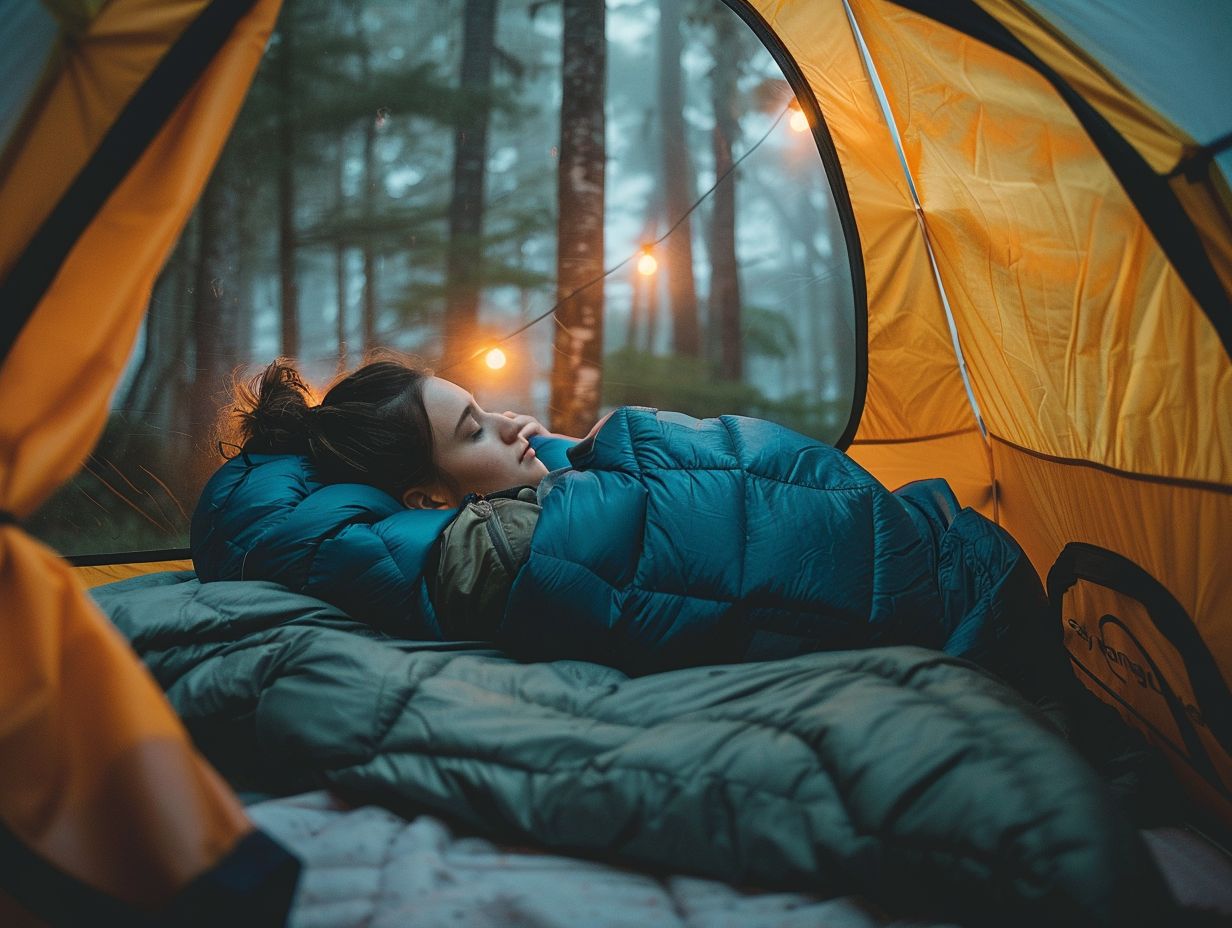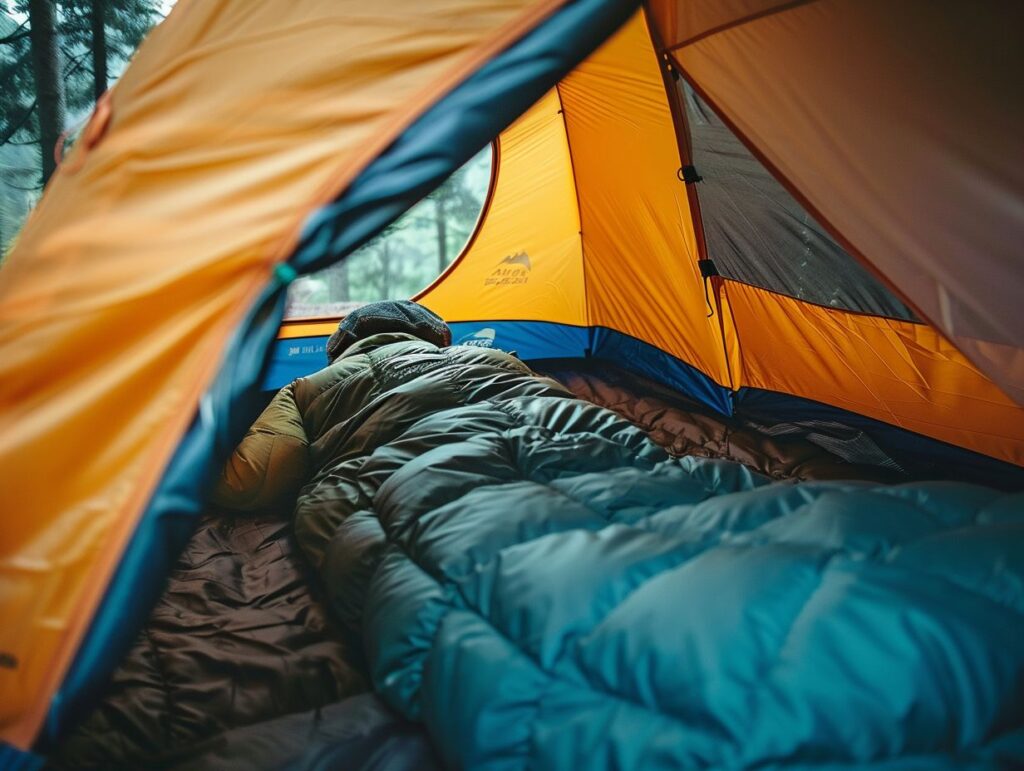Staying warm while sleeping in a tent is crucial for a comfortable and restful night outdoors. Factors like outside temperature, insulation of your sleeping bag, type of sleeping pad, clothing choices, humidity, and wind can all affect your body temperature.
We will explore the best ways to stay warm in your tent, including choosing the right sleeping bag, using a sleeping pad, wearing appropriate clothing, and more. We will also provide tips for staying warm in extreme cold conditions.
Make sure you stay cosy on your next camping trip!
Key Takeaways:
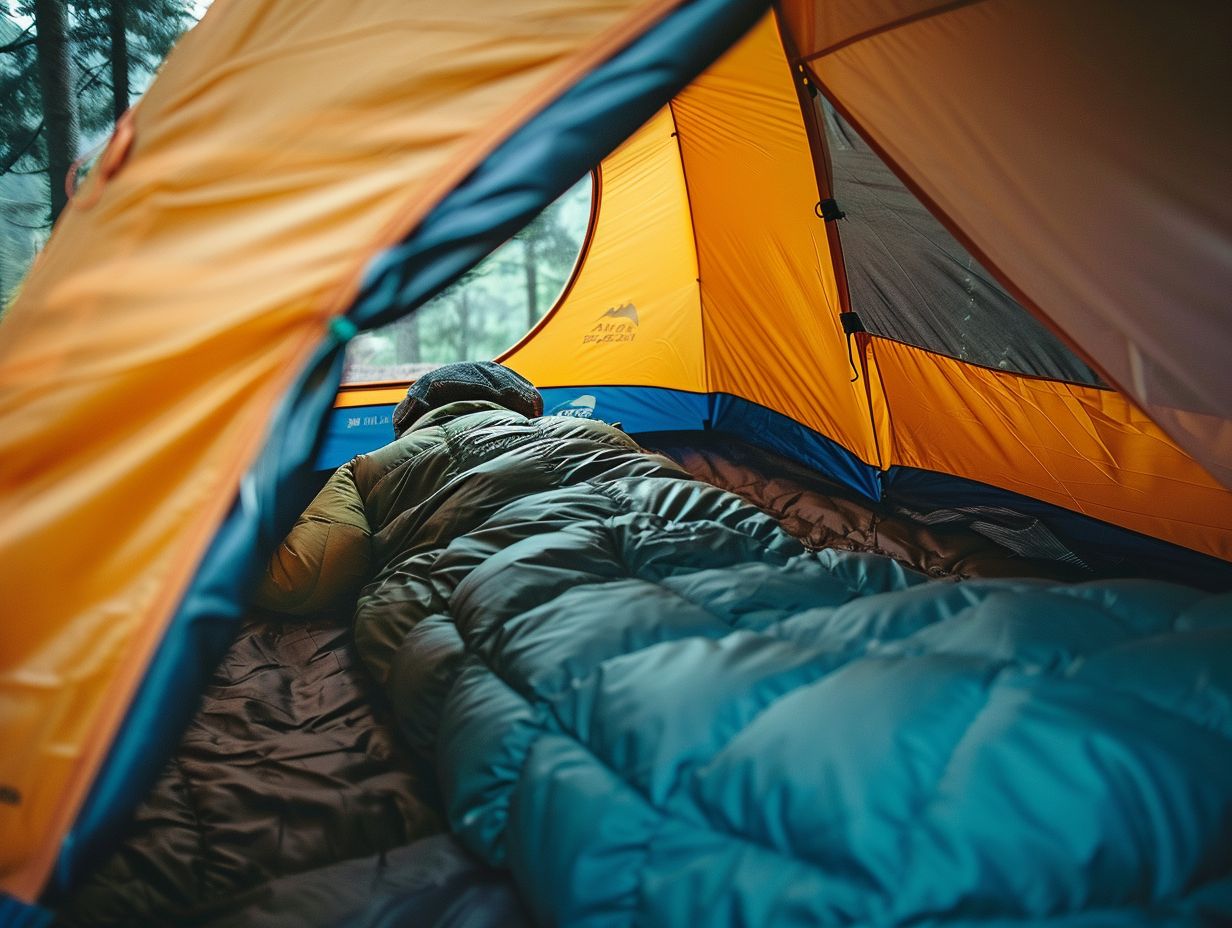
- Choose a high-quality sleeping bag with proper insulation to stay warm while sleeping in a tent.
- Use a sleeping pad to provide insulation from the cold ground and reduce heat loss.
- Layer your clothing and use hand and foot warmers to stay warm in extreme cold while sleeping in a tent.
What Are the Best Ways to Stay Warm While Sleeping in a Tent?
To maintain sufficient warmth when sleeping in a tent, it is essential to use a combination of suitable gear, heat sources, and practical tips and techniques, especially when participating in winter camping.
1. Choose the Right Sleeping Bag
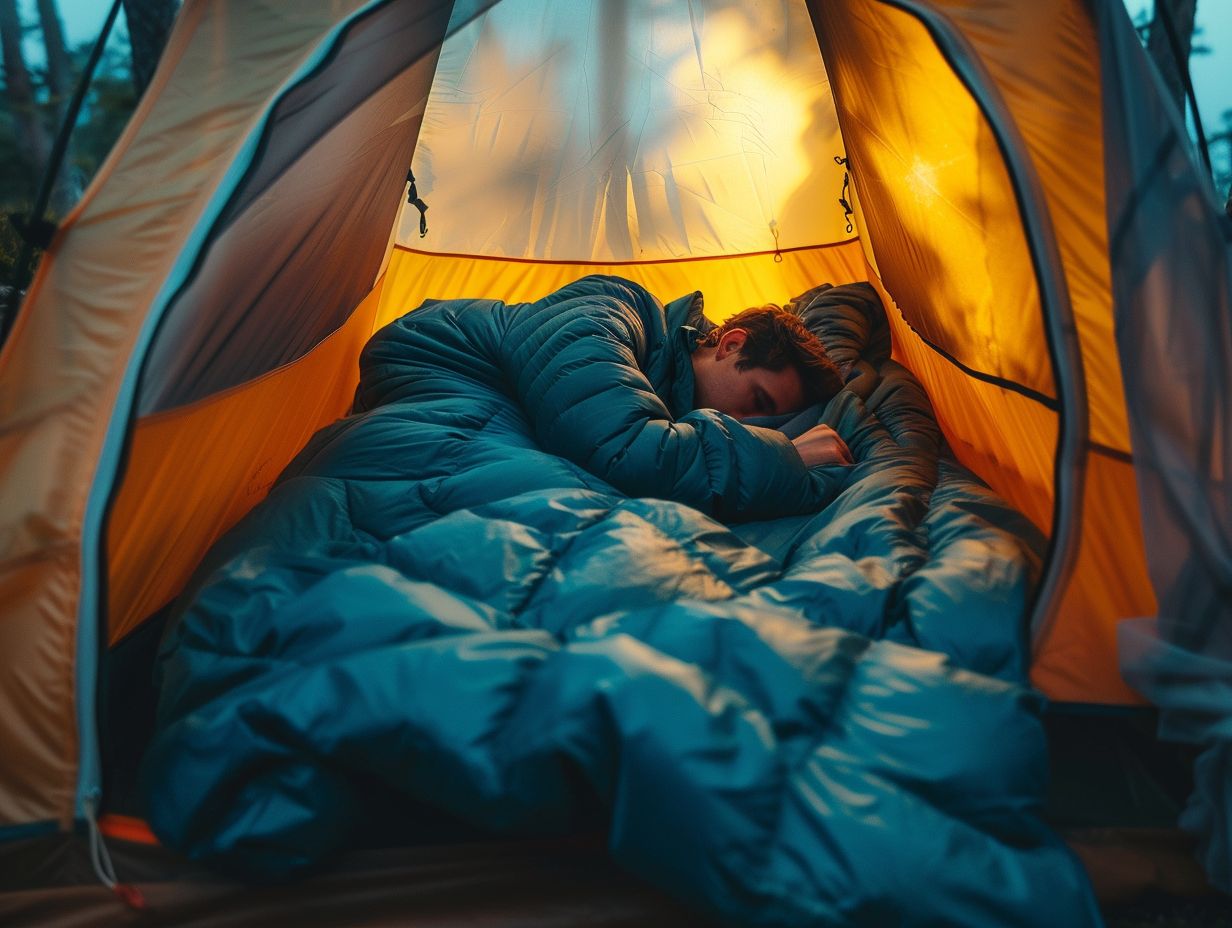
The selection of an appropriate sleeping bag, along with considerations for adequate insulation and additional layers such as down duvets and sleeping bag liners, can significantly impact the maintenance of warmth.
When choosing a sleeping bag, it is crucial to take into account the temperature rating to ensure optimal comfort in various environmental conditions. Features to look for include draught excluders, hoods, and materials with water-resistant properties to enhance insulation.
The inclusion of additional layers like down duvets can act as an extra barrier against cold temperatures, while sleeping bag liners can provide increased warmth and cleanliness. These additional layers not only improve insulation but also broaden the versatility of the sleeping bag, allowing its use across different seasons and making it a versatile choice for outdoor excursions.
2. Use a Sleeping Pad
Utilising a sleeping mat with a high R-value or an air bed can offer the necessary insulation against the cold ground, thereby improving overall warmth during outdoor activities.
When selecting the appropriate sleeping mat for outdoor excursions, it is imperative to take into account various factors such as insulation capability, thickness, weight, and durability. The R-value, denoting thermal resistance, stands as a critical attribute to consider when choosing a sleeping mat. A higher R-value signifies superior insulation properties that shield against the cold ground.
Moreover, the thickness of the mat plays a significant role in determining comfort levels, particularly for individuals who prefer sleeping on their side. It is advisable to opt for a sleeping mat that strikes a harmonious balance between cushioning and portability to ensure a restful night’s sleep amidst nature’s embrace.
3. Wear Appropriate Clothing
Ensuring proper attire is crucial for optimising warmth while camping in cold weather. The recommended clothing includes multiple layers made of materials such as wool and hardshell jackets.
Efficiently layering clothing involves starting with a moisture-wicking base layer to prevent sweat accumulation against the skin, followed by including insulating layers like wool or fleece for warmth. The final layer should consist of a hardshell jacket to protect against wind and moisture.
Wool is highly recommended for its insulating properties, even when damp, while hardshell jackets offer waterproof protection. By using these specific materials in a layered manner, individuals can stay warm, dry, and comfortable in challenging outdoor environments.
4. Use a Tent Heater
Utilising a tent heater, such as a wood stove or a propane tent space heater, can offer a reliable source of warmth, enhancing the comfort of your camping expedition.
Wood stoves remain a favoured option among campers due to their traditional ambience and capacity to deliver consistent heat. Conversely, propane tent space heaters are esteemed for their user-friendly set-up and customisable heat settings.
Regardless of the type of tent heater employed, it is imperative to prioritise adequate ventilation to avert the accumulation of carbon monoxide.
Maintaining a safe distance between flammable objects and the heater, and refraining from leaving it unattended are essential safety precautions. Adherence to these safety guidelines ensures a secure and pleasant camping venture while utilising a reliable tent heater.
5. Stay Hydrated and Eat Well
Maintaining body temperature and overall warmth during cold-weather camping is essential, and one must prioritize staying hydrated and consuming nourishing meals and hot beverages.
The significance of proper hydration cannot be overstated, particularly in cold climates where dehydration is a common concern. Opting for warm soups, herbal teas, and hot chocolate serves a dual purpose, as these options not only generate warmth but also ensure intake of essential nutrients.
Additionally, including meals rich in complex carbohydrates and healthy fats, such as porridge with nuts and seeds or a hearty vegetable stew, is highly beneficial.
These choices provide sufficient fuel to sustain energy levels amidst the brisk outdoor conditions. It is imperative to emphasize that a well-rounded diet and hydration regimen are fundamental components for ensuring a comfortable and energized camping experience.
6. Use Hot Water Bottles
Utilising hot water bottles as a heat source presents an effective method to maintain warmth within a sleeping bag during winter camping expeditions.
To employ hot water bottles in a safe and efficient manner, it is recommended to first fill them with hot water of a suitable temperature (avoiding boiling water) whilst allowing some space for expansion. Position the properly capped hot water bottles at the base of the sleeping bag to ensure a consistent supply of warmth throughout the night.
It is imperative to confirm the bottle’s security to prevent any leakage that could result in discomfort. Furthermore, insulating the hot water bottle with a cloth or towel is advised to avoid direct contact with the skin. By adhering to these straightforward guidelines, one can optimise the warming capabilities of hot water bottles during cold outdoor activities.
7. Use Body Heat
Utilising body heat, such as sharing a tent or sleeping close together, can be advantageous for maintaining a higher body temperature and optimising sleeping conditions on cold nights.
When individuals sleep in close proximity, they collectively generate warmth that effectively traps heat and circulates it within the sleeping area. This natural insulation conserves energy that would otherwise be expended on individual heat production.
Furthermore, it is important to acknowledge the emotional and psychological benefits of shared sleeping arrangements.
The feeling of security and comfort that arises from being in close proximity to others can promote relaxation, alleviate stress, and cultivate a sense of unity. Embracing shared sleeping arrangements can therefore offer both physical and mental warmth during cold nights.
What Are Some Tips for Staying Warm in Extreme Cold While Sleeping in a Tent?
Maintaining thermal comfort in harsh, cold environments during overnight stays in a tent necessitates adherence to specialised strategies designed for winter camping. Such approaches may encompass the utilisation of multiple sleeping bags, tent heaters, and the application of appropriate layering techniques.
1. Use Multiple Sleeping Bags
The use of multiple sleeping bags can significantly improve insulation and enhance sleeping conditions, particularly in extremely cold weather conditions.
Layering sleeping bags creates additional air pockets between the layers, which serve as supplementary insulation. These pockets of air effectively trap heat generated by the body, resulting in better heat retention and increased warmth throughout the night. Furthermore, the multiple layers act as a barrier against the cold ground, reducing heat loss through conduction.
This method is particularly beneficial in severe weather conditions or high-altitude environments where temperatures can plummet. By layering sleeping bags, individuals can tailor their level of warmth by adjusting the number of layers, thus ensuring a comfortable and snug sleeping environment.
2. Use a Tent with a Stove Jack
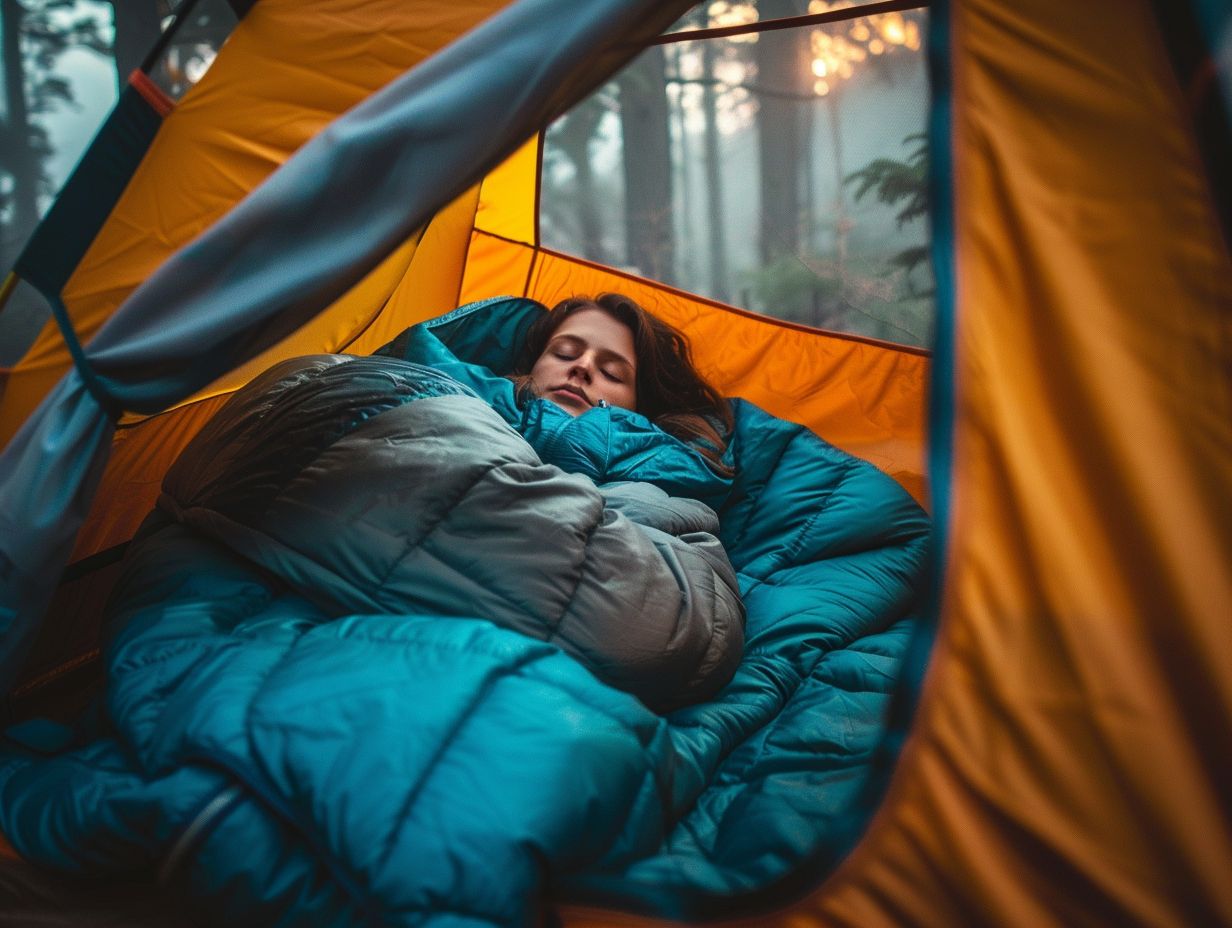
Utilising a tent equipped with a stove jack enables individuals to safely operate a wood stove within the tent, thereby offering a consistent heat source in extremely cold environments.
One advantage of incorporating a stove jack in a tent is its ability to effectively manage the smoke generated by the wood stove, thereby preventing its accumulation within the tent. The presence of a wood stove inside the tent affords individuals the ability to prepare meals, heat water, and maintain warmth, all while enjoying the comforts of indoor shelter.
To ensure the safe operation of a wood stove within a tent, it is imperative to prioritise proper ventilation, maintain a safe distance between flammable materials and the stove, and continuously supervise the fire. Adhering to these safety measures can enhance the overall camping experience by promoting safety and convenience.
3. Use a Hot Water Bottle Filled with Boiling Water
Utilising a hot water bottle filled with boiling water and positioning it inside a sleeping bag can offer prolonged warmth during exceptionally cold nights.
To ensure the safe and effective use of a hot water bottle, it is imperative to verify that the bottle is crafted from heat-resistant material to mitigate any potential accidents stemming from elevated temperatures. It is advised to encase the hot water bottle in a cloth or towel to prevent direct contact with the skin, as exposure to extreme heat may result in burns.
Optimal placement of the hot water bottle at the foot of the bed or in close proximity to the body can enhance its heat-retaining properties. Adhering to these safety measures enables individuals to relish the comforting warmth and cosiness afforded by a hot water bottle in a secure manner.
4. Utilise a Portable Heater
Using a portable heater, such as a propane tent space heater, can serve as an effective and reliable heat source during extremely cold winter camping expeditions. These portable heaters are available in a variety of types, including radiant heaters, convection heaters, and ceramic heaters.
Radiant heaters provide direct heat to objects positioned in front of them, making them suitable for targeted heating. Convection heaters work by heating the air and then circulating it throughout the space, ensuring a uniform distribution of heat.
In contrast, ceramic heaters are known for their energy efficiency and safety features, distinguished by their cool-to-the-touch exteriors.
When using a portable heater, it is essential to follow safety procedures, which include keeping flammable materials at a safe distance, ensuring sufficient ventilation, and never leaving the heater unattended.
5. Layer Your Clothing and Use Hand and Foot Warmers
Utilising a strategic approach for maintaining warmth and comfort during camping in extremely cold weather involves the method of layering clothing and utilising hand and foot warmers.
The practice of layering clothing aids in creating insulating pockets of air that effectively retain body heat whilst offering the flexibility to adjust warmth levels as required. Additionally, the usage of hand and foot warmers provides targeted heat to extremities, ensuring a comfortable environment and mitigating the risk of frostbite.
These compact yet efficient devices can be discreetly placed within gloves, boots, or pockets to deliver prolonged heat. By combining proficient layering techniques with the application of heated accessories, individuals can enhance both comfort and safety levels, enabling them to fully relish outdoor activities even amidst the most challenging weather conditions.
6. Eat and Drink Warm Foods and Beverages
The consumption of warm foods and beverages is beneficial for maintaining body temperature and ensuring adequate hydration while engaging in cold weather camping activities.
Choosing options such as hearty soups, hot cocoa, and tea can offer comfort and nourishment while camping in winter conditions. These warm meal choices not only supply necessary nutrients but also contribute to boosting morale and energy levels. The convenience of instant soup or oatmeal packets allows for quick and easy preparation while on the move.
Additionally, acquiring a portable stove or flask can enhance the experience of enjoying hot meals and beverages in outdoor settings. Emphasising the importance of warm food and drinks is essential for promoting comfort and sustaining energy levels during winter camping excursions.
Frequently Asked Questions
1. How can I stay warm while sleeping in a tent?
The key to staying warm while sleeping in a tent is proper preparation and gear. Make sure to have a warm sleeping bag, a sleeping pad for insulation, and wear layers of clothing to trap body heat.
2. What type of sleeping bag is best for staying warm in a tent?
A sleeping bag with a temperature rating that is suitable for the climate and temperature of your camping location is essential. Look for a bag with a lower temperature rating and additional features such as a draft collar or hood to keep you warm.
3. How important is insulation in staying warm while sleeping in a tent?
Insulation plays a critical role in keeping you warm while sleeping in a tent. A sleeping pad or air mattress, as well as a tent with good insulation, can help prevent the loss of body heat to the ground.
4. Should I sleep with my head covered in a tent to stay warm?
It is not recommended to sleep with your head covered in a tent, as this can lead to condensation and a buildup of moisture inside your sleeping bag. Instead, wear a warm beanie or hat to keep your head warm while allowing proper airflow.
5. What should I do if I still feel cold while sleeping in a tent?
If you are still feeling cold, try adding more layers of clothing or an extra blanket to your sleeping bag. You can also use a hot water bottle or hand warmers to add extra warmth to your sleeping bag.
6. Can I start a fire inside my tent to stay warm while sleeping?
No, it is not safe to start a fire inside your tent. The risk of carbon monoxide poisoning and fire hazards is high. Instead, build your fire outside the tent and use it as a heat source before going to bed, and make sure to properly extinguish it before entering the tent.
